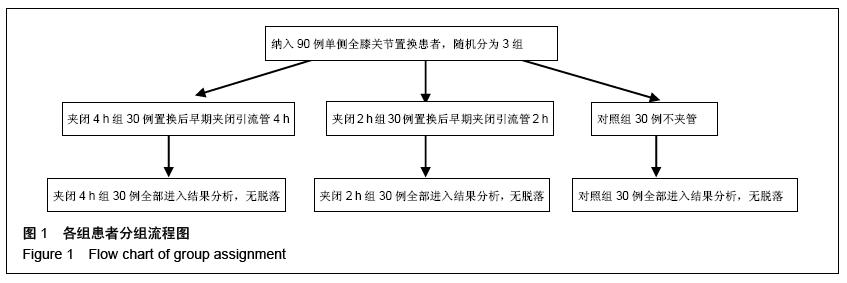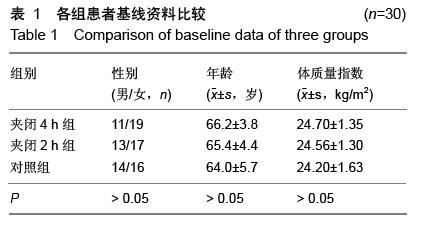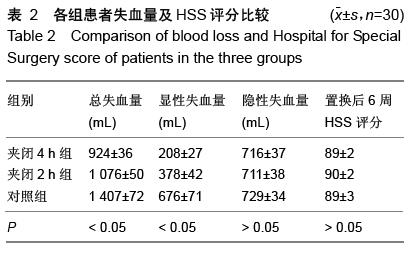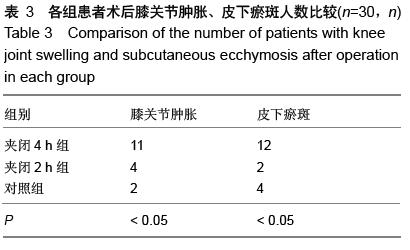| [1] 何国忠,庞清江.膝关节置换术后减少出血方法研究进展[J].现代实用医学,2012,24(6):718-720[2] Cross JB. Estimating allowable blood loss: corrected for dilution. Anesthesiology. 1983; 58(3):277-280[3] Nadler SB, Hidalgo JU, Block T. Prediction of blood volume in nor-mal human adults. Surgery. 1962; 57: 224-232.[4] Lotke PA, Faralli VJ, Orenstein EM, et al. Blood loss after total knee replacement. Effects of tourniquet release and continuous passive motion. J Bone Joint Surg Am.1991; 73(7):1037-1040.[5] Sehat KR, Evans R, Newman JH. How much blood is really lost in total knee arthroplasty correct blood loss manage-ment shout d take hidden loss into account. Knee. 2000;7(3): 151-155.[6] 覃健,余存泰,徐中和,等.全髋关节及全膝关节置换术后隐性失血的临床影响[J].中华骨科杂志,2006,26(5): 323-326.[7] 牛云峰,刘金榜,李广贤,等.减少全膝关节置换围手术期出血的探讨[J].中国骨与关节外科,2014,7(1):22-26.[8] Kazunari I, Nobuhiro T, Atsushi K. Intraarticular injection of tranexamic acid reduces not only blood loss but also knee joint swelling after total knee arthorplasty. Int Orthop. 2011;35(11):1639-1645.[9] 李军,王健,李阳,等.利伐沙班对人工全膝关节置换术后出血风险的影响[J]. 中国修复重建外科杂志,2011,25(11): 1323-1325.[10] Sebat KR, Evans RL, Newman JH. Hidden blood loss following hip and knee arthroplasty. Correct management of blood loss should take hidden loss into account. J Bone Joint Surg Br. 2004;4:561.[11] Erskine JG, Fraser C, Simpson R, et al. Blood loss with knee joint replacement. J R Coll Surg Edinb. 1981;26 (5): 295-297. [12] Faris PM, Ritter MA, Keating EM, et al. Unwashed filtered shed blood collected after knee and hip arthroplasties: a source of autolo-gous red blood cells. J Bone Joint Surg Am. 1991;73:1169.[13] McManus KT, Velchik MG, Alavi A, et al. Non-invasive assessment of postoperative bleeding in TKA patients with Tc-99m RNCs. J Nucl Med. 1987;28:565-568.[14] 刘杰,王栓科.TKA术后放置引流与否对围手术期失血量的影响[J]. 中国骨与关节损伤杂志,2011,25(4):364-365.[15] 巩建宝,孙水,张伟,等.初次全膝关节置换术后引流管夹闭时间选择与隐性失血的相关性研究[J]. 中国矫形外科杂志,2014,22(7):589-593.[16] 曹学伟,杨伟毅,梁比记,等.不同比血带使用方法对下KA围手术期失血量影响的临床研究[J].中国骨与关节外科,2011,4(6): 456-459.[17] 高乐才,吴文元.利伐沙班与低分子肝素对髋膝关节置换术后隐性失血影响的对比观察[J].现代中西医结合杂志, 2013,22(7):721-722.[18] 詹学华.人工全膝关节置换术后膝周冰袋冷敷对隐性失血的影响分析[J].中国中医骨伤科杂志,2011,19(8): 38-39.[19] 朱苏南.全髋全膝术后应用低分子肝素与隐性失血相关性研究[J].求医问药:下半月2012,10(10):530-531. [20] 许杰,马若凡,李亮平,等.应用低分子肝素对初次全髋及全膝关节置换后失血的影响[[J].中国组织工程研究, 2012, 16(48):8963-8967.[21] Prasad N, Padmanabhan V, Mulli A. Blood loss in totalknee arthroplasty: an analysis of risk factors. Int Orthop. 2007;31(1): 39-44.[22] Stucinskas J, Tarasevicius S, Cebatorius A, et al.Conven-tional drai nape versus four hour clamping drai nape after total knee arthroplasty in severe osteoarthritis: a prospective,randomised trial. Int Orthop. 2009;33(5): 1275-1278.[23] Shen PC, Jou I, Lin YT, et al. Comparison between 4-hour clamping drai nape and noncl ampi ng drainage after total knee arthroplasty. J Arthroplasty. 2005;20(7): 909-913.[24] Kiely N, Hockings M,Gambhir A. Does temporary clamping of drains following knee arthroplasty reduce blood loss? A randomised controlled trial. Knee. 2001; 8(4): 325-327.[25] Tsumara N, Yoshiya S, Chin T, et al. A prospective comparison of clamping the drain or post- operative salvage of blood in reducing blood loss after total knee arthroplasty. J Bone Joint Surg Br. 2006;88(1): 49-53.[26] Tai TW, Yang CY, Jou IM, et al. Temporary drainape clamping after total knee arthroplasty: a meta-analysis of randomized controlIed trials. J Arthroplasty. 2010; 25(8):1240-1245.[27] Huang ZY, Ma J, Pei F, et al. Meta-analysisof temporary versus no clamping in TKA. Orthopedics. 2013;36(7) : 543-550.[28] Seo JG,Moon YW,Park SH,et al.The comparative efficacies of intra-articular and IV tranexamic acid for reducing blood loss during total knee arthroplasty. Knee Surg Sports Traumatol Arthrosc. 2013;21(8): 1869-1874.[29] Antinolfi P, Innocenti B, Caraffa A, et al. Post-operative blood loss in total knee arthroplasty: knee flexion versus pharmacological techniques. Knee Surg Sports Traumatol Arthrosc. 2014;22:2756-2762.[30] Hourlier H, Reina N, Fennema P. Single dose intravenous tranexamic acid as effective as continuous infusion in primary total knee arthroplasty: a randomised clinical trial. Arch Orthop Trauma Surg. 2015;135:465-471.[31] Sabatini L, Atzori F, Revello S, et al. Intravenous use of tranexamic acid reduces postoperative blood loss in total knee arthroplasty. Arch Orthop Trauma Surg. 2014; 134:1609-1614.[32] 许杰,马若凡,李亮平,等.应用低分子肝素对初次全髋及全膝关节置换后失血的影响[J].中国组织工程研究, 2012, 16(48):8963-8967.[33] 高玉镭,李佩佳,田敏,等.人工全膝关节置换术隐性失血的发生机制及影响因素分析[J].中国矫形外科杂志, 2012, 20(3):209-212.[34] 丛宇,曾晓峰,包倪荣,等.人工关节置换术后隐性失血的影响因素及相关机制[J].医学研究生学报,2011,24(6): 611-614.[35] 邱旭升,陈东阳,徐志宏,等.全膝关节置换术后隐性失血危险因素的分析[J].实用骨科杂志,2012,18(6):510-512.[36] Malone KJ,Matuszak S, Mayo D, et al. The effect of intra-articular epinephrine lavage on blood loss following total knee arthroplasty. Orthopedics. 2009; 32:100.[37] Anderson LA, Engel GM, Bruckner,JD, et al. Reduced blood loss after total knee arthroplasty with local injection of bupivacaine and epinephrine. J Knee Surg. 2009;22:130-136.[38] Li B, Wen Y, Liu D, et al. The effect of knee position on blood loss and range of motion following total knee arthroplasty. Knee Surg Sports Traumatol Arthrosc. 2012;20:594-599.[39] 吴建国.全膝关节置换术后膝关节位置对术后失血的影响[J].中华关节外科杂志:电子版,2011, 5(2): 19-21.[40] Napier RJ, Bennett D, McConway J, et al. The influence of immediate knee flexion on blood loss and other parameters following total knee replacement. Bone Joint J. 2014;963:201-209. |
.jpg)



